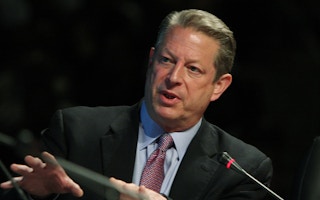Mother Nature is angrier than ever before, and so is Al Gore.
If the former Vice President of the United States was calm, poised and persuasive in the Oscar-winning documentary An Inconvenient Truth, then he rages, despairs and hopes again in An Inconvenient Sequel: Truth to Power.
The sequel, released in Singapore on 17 August, comes 11 years after the Oscar-winning original catapulted climate change into the public consciousness, and is no less terrifying and inspiring than the first.
Panning across fields of crumbling glaciers, towns flattened by hurricanes, and bone-dry riverbeds, the film depicts scenes from the decade sandwiched between the two documentaries. In this period, natural disasters have occured more frequently, and have been more severe than expected.
Watching news on the TV is now a “nature hike through the Book of Revelations”, Gore comments mirthlessly to the audience, referring to the chapter in the Bible depicting the end of the world.
Gore is more honest with his anger and despair in his newest offering, now screening globally. The “recovering politican”, as he calls himself, raises his voice when he talks about how the warming climate makes the world more hospitable for mosquitoes, vectors of the Zika virus. He continues to work on his presentations like the one he delivers in An Inconvenient Truth about climate change because, he says, that’s the only way he knows how to keep on fighting.
At the heart of this documentary is a challenge faced by all who work in environmentalism and sustainability today: Realigning political and economic systems to combat climate change. An Inconvenient Sequel reveals the tangled web of politics and power that gave the world climate deniers, Donald Trump, but also the triumph of the Paris Agreement.
“To fix the climate crisis we need to fix democracy”, Gore declares at one point.
For much of its 100 minutes, the film is both frightening and encouraging. It is one thing to show audiences scenes of devastating natural disasters, but what put the fear of climate change in me (again) was seeing the streets of Miami flooded on a regular, sunny day. That could be our new normal.
On the flip side of the climate doom scenarios, it makes the point that the moral case for becoming more sustainable has now been exceeded by the business case. As technology for renewable energy becomes cheaper, even staunchly Republican towns are switching to 100 per cent carbon-free power, simply because it makes economic sense to do so.
A convenient story
But despite the strengths of An Inconvenient Truth, it often feels like its filmmakers have chosen to go with the story that was easiest to tell rather than embrace the intricacies of the dynamics underlying climate action. This is why I don’t think this sequel merits the canonical status of An Inconvenient Truth.
The documentary depicts the struggle for the Paris Agreement with the traditional tropes of a hero, his quest and a victory. The victory is the landmark signing of the Paris Agreement, the hero is Gore, and the challenge, in his words, is “an India problem, first and foremost”. Gore is approached by other climate leaders to help persuade the Asian country to switch to renewable energy and help pass the international treaty.
It shows Indian officials squaring off with the US former Vice President, adamant that India should not shoulder the burden of cleaning up the environment after developed countries have been wearing down the climate for decades. Its climate negotiators took a firm stance: Without funding assistance for its clean energy programmes, India will not reduce its use of coal.
On one hand, it’s important that the sequel devotes screentime to the role of developing countries as victims and key actors in the fight against climate change—the absence of these countries being my main grouse about the first instalment.
But by casting India as the stubborn hold-up to the Paris Agreement, the documentary does a great disservice to the very cause it seeks to champion, and this has two disturbing effects.
Firstly, by presenting India’s concerns as an act of wilfulness rather than a question of historical responsibility, it undermines the idea of climate justice, and the fact that many developing countries are struggling to adapt to a world whose climate they had little part in ruining.
Secondly, by framing climate change negotiations as a win-lose situation, the very message the film attempts to make is diluted: that there are no winners in climate change. Everyone is saved, or no one is safe.
Another point of contention is Gore’s actual role in securing India’s signing on to the Paris Agreement. Despite the revolving door of world leaders who appear in the documentary, it is Gore that ultimately saves the Paris Agreement. He is seen convincing US solar energy services firm SolarCity to share technologies with India in exchange for the latter withdrawing objections to the agreement.
While the trade is almost certainly Gore’s idea, E&E news has reported Ajay Mathur, one of India’s lead negotiators in Paris, as saying: “None of us recall any discussion in the negotiating team on any such linkage; I don’t recall an offer of solar technology being discussed at all.”
A Gore spokeswoman is quoted in the article as saying that only India’s energy minister and then-minister for the environment, forests and climate change had known about the deal, and the directors have given pretty weak answers as to why that was chosen as the pivotal moment in the film.
Gore’s multiplier effect
The film captures Gore pushing the climate agenda in other ways as well, which one can argue have been more successful. He shows his true strength as a messenger of climate change action in the scenes where he’s delivering his climate presentations.
Having campaigned for the environment longer than I have been earning a disposable income, Gore comes across as sincere, authoritative, and dedicated. These powers he put to use while rallying a taskforce of climate activists known as Climate Reality Leaders around the world through his Climate Reality Project.
One such climate leader is 27-year-old Vahram Ayvazyan. I first met him in Colombia in 2016, where we were both volunteering as English language teachers in the same city.
An Armenian, Ayvazyan had been trained in a three-day course at Cedar Rapids, Iowa with politicians, scientists and Gore himself in 2015. He says the course was a valuable chance to learn more about climate change and activism, to network, to improve debate skills through workshops. “I could look at climate change from different perspectives and get into the nitty gritty of climate politics, and what climate deniers say and do. It helped me research more thoroughly,” he said.
To this day, Ayvazyan continues to put the lessons he learnt at Gore’s course into action. He’s now running a start-up in Colombia that builds generators to extract clean water, generate energy, purify air, and collect environmental data.
As a documentary, the sequel to An Inconvenient Truth sidesteps the intricacies of climate negotiations and climate justice in favour of an unnecessarily heroic narrative.
Gore’s work already speaks for itself, and his legacy will be in educating others about climate change and empowering other activists to debunk climate denial and fight for a safe future. He’s undoubtedly secured a place in history for his tireless campaigning. It’s unfortunate that An Inconvenient Sequel was a less-than-ideal reflection of that.


















